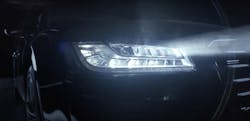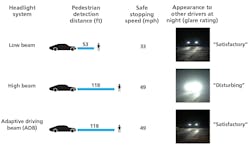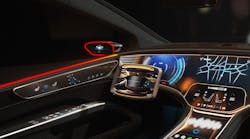INDUSTRY INSIGHTS | Unnecessary evil: Glare in driver visibility
Over the past several months, scientists at the Light and Health Research Center have seen an uptick in inquiries about headlight glare. This piece aim to clarify why and update readers on how headlight glare is being addressed in the U.S.
Light source evolution and standards
The trade-off between providing forward visibility for drivers and minimizing glare for oncoming drivers has always been a challenge. Low-beam halogen headlight photometric standards were developed to help ensure a balance between these opposing entities. High-beam halogen headlights were designed to enhance forward visibility only when other drivers would not be blinded. Indeed, an unwritten social contract evolved many years ago whereby a driver would never energize high-beam headlights in the presence of oncoming traffic.
Low-beam photometric standards were developed for a static, unchanging halogen headlight beam pattern, driven by a sensitivity to the compromise between good forward visibility and bad oncoming glare. Low-beam headlights provided adequate visibility for vehicle drivers while minimizing excessive glare to approaching drivers. Until about 25 years ago, when halogen headlights began to be replaced by other light sources, this headlight stalemate was generally accepted by drivers.
Compared to halogen sources, newer LED technology proved more durable, more efficient, brighter, and easier to optically control with regard to beam intensity distribution. As a result, the balance between forward visibility and oncoming glare began to change in favor of the driver trying to see the road ahead. But in doing so, drivers approaching in the opposite direction began to feel disadvantaged by oncoming headlight glare. Thus, complaints about glare have increased considerably within the past 25 years, most of them due to the new light source technology itself.
These complaints are almost certainly justified, but not because LED light source technology is fundamentally bad or even poorly designed. Quite the contrary: The existing glare problem is not inherent in the light source technology nor in the unwritten social contract among drivers. There is no evidence that drivers use high-beam headlights indiscriminately. Rather, the problem has several other causes.
First, photometric standards have not evolved with changes in the spectral power distribution of LED technology. Second, enforcement of existing standards has become lax. And third, current standards do not fully recognize the ancillary technologies that dramatically improve visibility for all drivers while eliminating headlight glare.
How have headlights changed over the past 25 years? The light emitted by LEDs has become bluer, brighter, sharper, and more focused — all of which help a driver see better at night. A bluer LED light in fact is brighter to the human eye than the same measured level of yellower light emitted by halogen headlights. In effect, the conventional photometry underlying all lighting standards simply does not capture this enhanced LED brightness, which, in fact, also increases real glare from oncoming headlights.
Exacerbating the photometric insensitivity to brightness and glare in standards, most state governments no longer require drivers to have properly aimed headlights. A recent study from the Light and Health Research Center laboratory found that nearly two-thirds of licensed automobiles had one or both headlights misaimed. Because contemporary headlight beams are more focused than previous technologies, a significant increase in glare from misaimed headlights is more likely. With a greater proportion of sport-utility vehicles and pickup trucks with high-mounted headlights on the road, those misaimed and highly focused headlights are even more likely to direct greater amounts of light into drivers’ eyes. Out-of-date standards that are no longer enforced means there will be more justifiable complaints about glare from LED headlights.
Improving automotive LED performance
What is important is that none of that need matter. Halogen headlights produced fixed high and low beams that were shaped by reflectors or refractors to meet static photometric standards. While limiting glare for other drivers, halogen low beams were not particularly good for revealing roadway hazards at a distance, nor were they suited to revealing closer hazards that might enter the roadway because the reflectors and refractors shaping the light from a filament lamp were optically limited.
LED headlights usually do not produce a single beam. Rather, they often produce many small, discrete beams from multiple LED sources (see image at top of article). This means the optical characteristics of multibeam headlights can be tailored to illuminate — or not illuminate — any area ahead of the driver.
Coupled with advanced camera technology and computer software, each discrete beam can be modulated in real time. Functionally, this means the windshield of an approaching vehicle or the rearview mirror of a followed vehicle can remain in continuous shadow at any time, distance, or speed. Simply put, if the windshield or the rearview mirror of another driver is in shadow, there is no glare (Fig. 2).
Using many small, discrete beams also allows drivers to enhance the illuminance anywhere in the visual field where potential hazards occur on or off the roadway.
That is, the driver can operate with high beams all the time without violating the social contract to minimize glare for other drivers. And since advanced headlight systems are self-correcting, there is little need for improving the old photometric standards and aim requirements — or for enforcing them.
Such advanced headlight systems are on European roads now but not in the U.S. This is odd because it would seem that new standards for advanced headlight systems like those now common in Europe could be implemented here. The goal of a new standard would be to rebalance and, indeed, improve the old headlight stalemate between drivers traveling in opposing directions on U.S. roadways by providing better visibility without greater glare.
In fact, a U.S. standard for advanced headlight systems has existed since February 2022. However, there are no vehicles with advanced headlight systems driving in this country. Vehicle manufacturers are finding it challenging to quickly implement the new and complex standard — which is nearly as long as all previous vehicle lighting regulations combined. As a result, it’s not clear when the implementation of advanced headlight systems in the U.S. will catch up to the technology.
Perhaps the uptick in the public’s interest regarding headlight glare will facilitate implementation of a new standard, because advanced headlight systems can demonstrably improve safety while reducing glare for all drivers — and this would be a win-win for all.
Research focus: Advanced headlighting benefits
The research team at the Light and Health Research Center studied the safety impacts of adaptive driving beam (ADB) headlights in terms of improved visibility and reduced glare1. In a previous field experiment, we measured detection distances to simulated pedestrians along the road while driving a vehicle with an ADB system and while driving the same vehicle with fixed low-beam headlights. As shown in the central portion of Fig. 1, drivers responded that they could see the simulated pedestrian at more than twice the distance with ADB headlights compared to when conventional low-beam headlights were used.
Analyses of visual performance under low beam and ADB headlighting systems2,3 show that ADB headlights can help drivers see road pavement markings and potential hazards along the road from farther away than low-beam headlights. Importantly, the benefits of ADB headlights were greater for older drivers in their 60s than for younger drivers in their 20s.
In a second field experiment1, the vehicle with the ADB headlighting system was driven past another vehicle while it had either fixed low-beam headlights, fixed high-beam headlights, or the ADB system switched on. Occupants of the second vehicle reported their level of discomfort glare after the vehicle passed. Ratings for the high beams corresponded to a “disturbing” level of discomfort glare. Ratings for the low beams and for the ADB headlights were nearly identical and corresponded to a “satisfactory” degree of glare (see figure, right). We believe that ADB headlights can help reduce nighttime crashes on our roads by improving roadway visibility for drivers while mitigating disturbing glare for other road users.
REFERENCES
1. J.D. Bullough, N.P. Skinner, T.T. Plummer, “Assessment of an adaptive driving beam headlighting system: Visibility and glare,” Transportation Res Record, 2555, 81–85 (2016).
2. J.D. Bullough, “Intelligent vehicle lighting: Impacts on visual perception of drivers varying in age,” Soc Automotive Engineers International J Advances and Current Practices in Mobility, 3, 5, 2627–2632 (2021).
3. J.D. Bullough, “Benefits of adaptive driving beam headlights for visibility of road pavement markings,” Société des Ingénieurs de l’Automobile Vehicle and Infrastructure Safety Improvement in Adverse Conditions and Night Driving Congress, Paris, France, March 17–18, 2021.
At the Light and Health Research Center, part of Icahn School of Medicine at Mount Sinai in New York, MARK REA and JOHN BULLOUGH conduct research to advance the science of lighting to improve human and environmental wellbeing.
Follow our LinkedIn page for our latest news updates, contributed articles, and commentary, and our Facebook page for events announcements and more. You can also find us on Twitter.
John Bullough | Researcher, Light & Health Research Center, Mount Sinai's Icahn School of Medicine
At the Light and Health Research Center, part of Icahn School of Medicine at Mount Sinai in New York, JOHN BULLOUGH conducts research to advance the science of lighting to improve human and environmental wellbeing.
Mark Rea | Researcher, Light & Health Research Center, Mount Sinai's Icahn School of Medicine
At the Light and Health Research Center, part of Icahn School of Medicine at Mount Sinai in New York, MARK REA conducts research to advance the science of lighting to improve human and environmental wellbeing.








